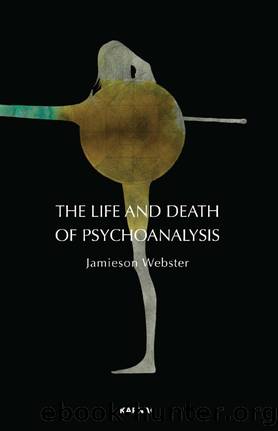The Life and Death of Psychoanalysis by Webster Jamieson;

Author:Webster, Jamieson;
Language: eng
Format: epub
Publisher: Karnac Books
Published: 2011-07-06T16:00:00+00:00
Unlike the elaboration of a symptom in psychoanalysisâthe work of unraveling the network of signifiersâwriting is closer to the formula of desire. It is closer to the formal qualities of unconscious desire: the very interplay, or play, of the signifier.
Patients come and they are certainly their particular selves. I do not intend to invoke the opposite register as one of diffusion, pathologizing as a vindication of identityâthe Athenians were playing at that game long enough. If desire inhabits us as something that must remain alien, then it is not that the alien is gone once and for all at the end of analysis, a kind of anal fantasy. Where we stop cannot be a point of assimilation or imagined eradication. Lacanâs play with this idea of signature is one way to talk about the end of an analysisâa singular mobilization of desire, a radical change in structure. This act of writing or signature is a way of putting to use a particular symptom rather than stagnating in the face of it.
I think the distinction between knowledge (conaissance) and know-how (savoir-y-faire) is important here. One does not understand desireâ which in any case would be interminableâone finds a know-how through it. What analysis cultivates is oneâs unique signature that is both a way of being with desire and desires way of being. Signature and signifier become the formal play and act, not as a source of meaning, but a means of punctuation. Period. Exclamation. Semicolon. End. Lacan says in the Les Non-Dupes Errent seminar (1973), âone has to stop. One even asks for nothing but thatâ (L.13.11.73, p. 22). Meaning is endless.
The question of desire becomes central for Lacan in reinterpreting the importance of the limit and act of psychoanalysis. He discusses Freudâs essay, The Dissolution of the Oedipus Complex (1924), noting that if the child has to reconcile himself with a narcissistic investment in his own body, the castration threat, against his incestuous desire in the familial complex, he will always choose to salvage his narcissism and turn away from his desire. But this is no solution. It still leaves the question of desire hanging in the balance. It seems that the child must come to terms with incestuous desire and abandon a narcissism that can only be a way station on the path toward desire for other objects.
For Lacan, a work of mourning must take place. In the case of the boy, for example, to desire his mother leaves him vulnerable to the threat of his fatherâs punishment, while on the other hand, to be the object of his fatherâs desire leaves him likewise castrated since he is in the feminine position. However you render this story, sexuality, having a body, conflicting gender identifications, locating yourself in the generational turn, have a significant impact that requires signification. The temptation to resolve these through being the object of desire (rather than the complicated subject of it) is a problem that Lacan called the problem of being the phallus for the Otherâwanting to be for them what they are irrevocably lacking.
Download
This site does not store any files on its server. We only index and link to content provided by other sites. Please contact the content providers to delete copyright contents if any and email us, we'll remove relevant links or contents immediately.
Bioenergetica by Alexander Lowen(1371)
The Child in You by Stefanie Stahl(1155)
Noise: A Flaw in Human Judgment by Sunstein Cass R. & Sibony Olivier & Kahneman Daniel(1118)
No Bad Parts by Richard C. Schwartz(1091)
The Data Detective by Tim Harford(1062)
Chatter by Ethan Kross(992)
The Science of Rapid Skill Acquisition by Peter Hollins(839)
Freedom by Sebastian Junger(774)
The Montessori Baby by Simone Davies(760)
The Quantum Psychiatrist: From Zero to Zen Using Evidence-Based Solutions Beyond Medication and Therapy by Biswas Dona(737)
Maps of Meaning: The Architecture of Belief by Jordan B. Peterson(676)
Evolution Gone Wrong: The Curious Reasons Why Our Bodies Work by Alex Bezzerides(641)
The Science of Self-Learning: How to Teach Yourself Anything, Learn More in Less Time, and Direct Your Own Education (Learning how to Learn Book 1) by Peter Hollins(631)
Sadomasochism and the BDSM Community in the United States by Stephen K. Stein(610)
Anxiety For Dummies by Charles H. Elliott & Laura L. Smith(606)
Why Sex Doesn't Matter by Olivia Fane(599)
Disconnected by thomas Kersting(591)
Jung - The Key Ideas: Teach Yourself (TY Philosophy) by Ruth Snowden(567)
The Mechanics of Passions: Brain, Behaviour, and Society by Alain Ehrenberg(565)
